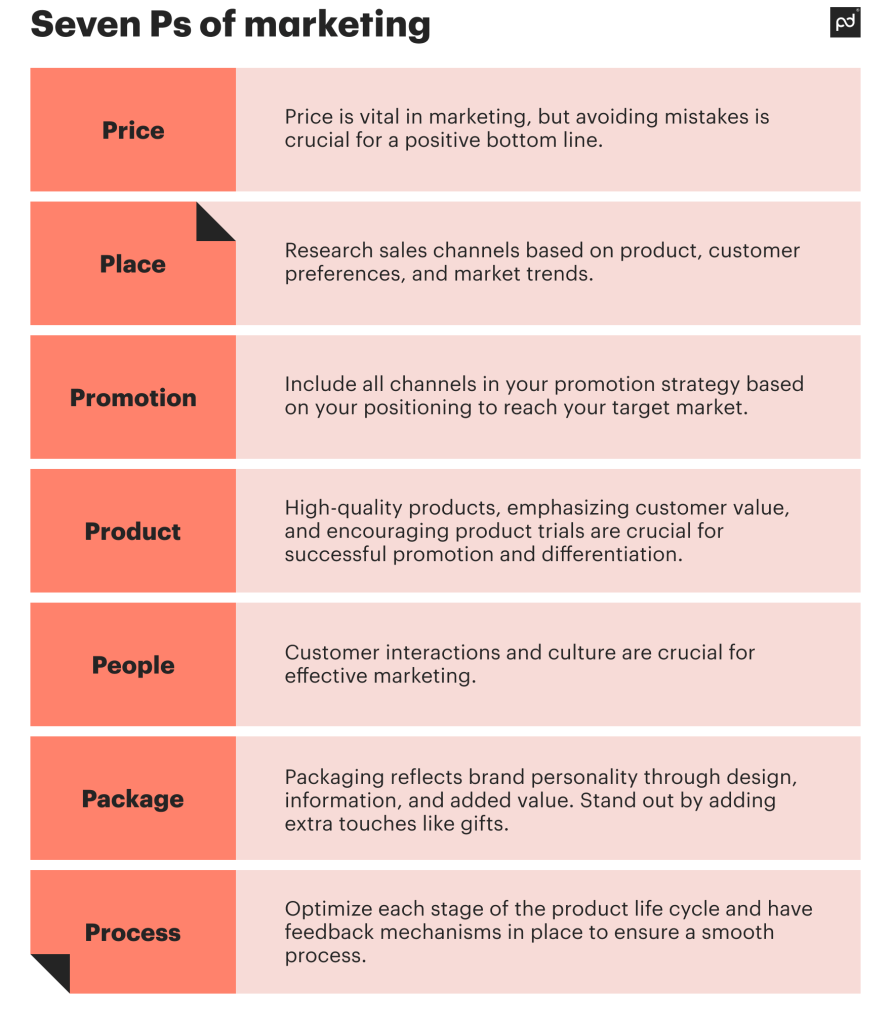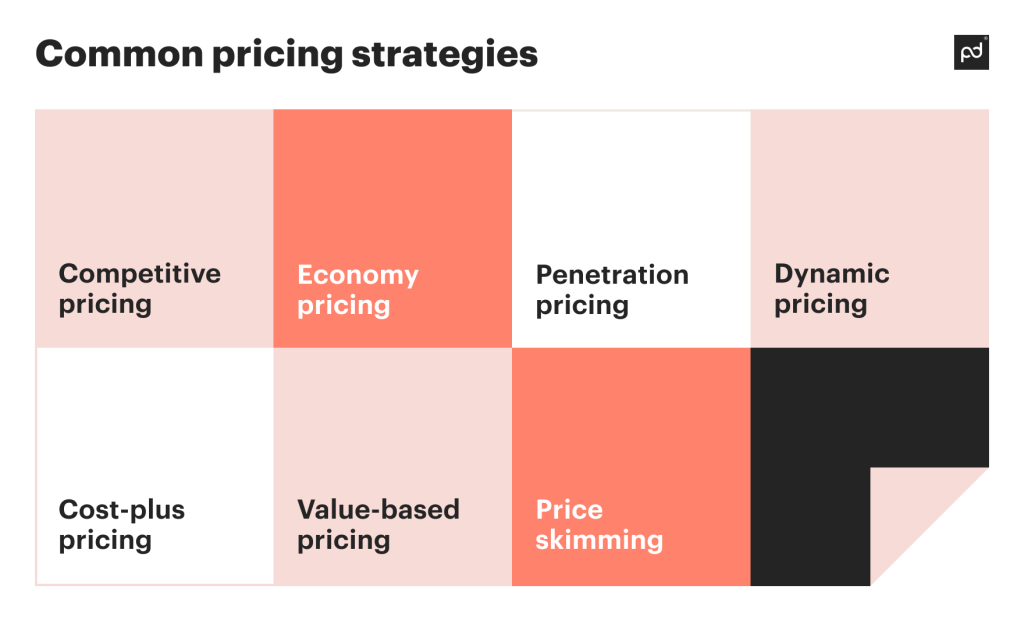How does price relate to successful marketing?
We all know that cheaper prices will attract more buyers, but there’s actually a lot more to it than that.
Let’s have a closer look at the whys and hows of setting the right price, including different pricing strategies and how to approach the task of choosing the right one for your business.
But first, we need to talk about the marketing mix.
What is the marketing mix?
Anyone considering how to write a marketing plan will need to understand the marketing mix.
It’s a basic marketing concept that’s essential to get right in any competitive marketplace.
The marketing mix is the combination of tactics and approaches you use to get potential customers interested in buying your product or service.
A common framework for this is known as the seven Ps of marketing: Product, price, promotion, place, people, packaging, and process:

Product
It all begins with your product.
Even the best promotion strategy will fail if it isn’t backed up by a high-quality product.
So it’s vital to focus on perfecting your offering before trying to market it to your target customers.
This means thinking about every single aspect of your product or service, including:
- Quality
- Design
- Market positioning
- Optional add-ons.
A key factor here is focusing on customer value. Make sure you understand the customer needs of your target market.
Achieving differentiation from similar products in the market may be challenging. But it can be done.
One of the best ways of doing this is to let your product speak for itself.
That’s to say, focus on getting potential customers to try it out for themselves so they can understand how good it is.
Price
The price of a product is another important factor of the marketing mix.
Setting the right price can be tricky. Broadly speaking, business owners follow one of these different pricing strategies:
- Low price: Setting a lower price than the competition to attract new customers
- High price: Setting a higher price than the competition to indicate higher quality. This targets the “you get what you pay for” idea.
- Same price: Setting a similar price to competitor pricing and highlighting features and benefits that make your product better
- Penetration pricing: This is where you set a low price to begin with when you launch your product, then raise it later once the customer base is established.
- Value-based pricing: A customer-led pricing model. The price is chosen according to the perceived value of the product to the customer.
Each pricing model can give you a competitive advantage if used correctly.
Nevertheless, it’s crucial to avoid price mistakes.
For example, rock bottom pricing may appeal to your target customers, but if you’re not adding a markup on top of your production costs, you can get caught in a low-price spiral that loses you money. Even with a high sales volume, that will hurt your bottom line.
Promotion
This element of the marketing mix is the most visible.
Your promotion strategy should cover all the channels you’re using to reach out to your target market. This may include a mixture of traditional media advertising, a strong social media presence, email marketing, and so on.
The marketing plan you choose will depend on your positioning.
For instance, while a large enterprise may go down the more traditional route, entrepreneurs running a small business startup may find content marketing and influencer promotion leads to better results.
Place
Where you sell your product can be as important as how you sell it. You need to conduct appropriate market research to understand where your customer base will expect to find you.
Partly, this will come down to the nature of the product itself. If you’re selling an item that people want to touch before they buy, you’ll need a real-world location.
That way, your target audience can get their hands on the physical evidence.
On the other hand, if you’re selling something where quality can be assessed at a distance, such as software, this won’t be necessary.
Keep an eye on market trends, too. Change does happen.
There was a time when selling clothes successfully online was considered unlikely. Surely the customer would need to try the items on before purchase?
Then, some savvy eCommerce retailers realized that making returns easier could crack this problem.
It worked. By 2021, the global online fashion industry was worth $668 billion.
People
You hire the best talent, right? The people your target customers come into contact with say a lot about your brand.
And that doesn’t just mean on the public relations side. Everyone who interacts with your customers leaves an impression.
The “people” part of the mix contributes just as much to the effective marketing of a new product as competitive pricing.
From the customer-facing staff, such as customer support teams, to the behind-the scenes developers, everybody can make a difference.
So, it’s vital to place an emphasis on creating a company culture that puts the customer first.
Craft a CRM strategy that will inspire loyalty in your customer base.
Making sure that everyone across your organization can deliver a consistent and high quality experience to prospects and leads (and existing customers) is crucial.
A big part of that is ensuring that everybody has knowledge of and easy access to the most up-to-date information and business documents.
Your sales and marketing teams—and everyone else—need to be able to easily stay on top of brand guidelines, the latest product offerings, accurate pricing information, and more.
That’s where a document workflow solution like PandaDoc comes in.
PandaDoc for sales makes it easy for reps to control and manage what’s available to sell and to track deals in real-time.
PandaDoc for marketing, meanwhile, lets you create, collaborate on, and share hyper-personalized documents, company-wide.
Packaging
We all know how important brand visuals can be for a marketing strategy.
Packaging is one of the most obvious examples of that.
How you wrap your products has a huge impact on how your target audience responds. It’s an opportunity to promote your brand personality, so focus on:
- Design: First and foremost, make your design stand out from the rest. It’s an ideal way to achieve product differentiation.
- Information: As well as clear instructions for use of the new product, you can strengthen your brand credentials by adding additional information to educate or entertain your customers.
- Value: Is there a way you can add a little extra? An eCommerce gift retailer might add a small, unexpected bonus like some stickers, for example. Everyone likes getting a free gift.
Process
Make sure the nuts and bolts of your operation are in order.
Every stage of the product life cycle should work seamlessly with the next. This means everything from initial development to distribution logistics and customer support.
If one part of the machine isn’t optimized, things can quickly go awry.
Ensure you have feedback mechanisms in place to identify any issues before they turn into a public relations problem.
If you’re currently drawing up your marketing plan, you might find PandaDoc’s marketing strategy presentation template helpful.
Why is price important?
These seven Ps of marketing are a useful guide to the marketing mix.
Each has its part to play in effective marketing campaigns. But for now, we’re going to hone in on the importance of pricing in marketing.
Your pricing model is an important factor in your marketing strategy because it has a direct impact not only on your profit margins, but on supply and demand as well.
Selling a product for a lower price will attract more buyers, and supply will need to increase to meet demand.
The price points you choose for your products also send a message.
A higher price point may be an indicator of the product’s high quality, whereas a lower price point suggests a budget-conscious choice.
One thing to remember is that the price of a product can be changed instantly.
Putting your prices up or down has no immediate impact on your variable costs.
This makes it different from some of the other Ps of marketing such as packaging, for example.
If you change your packaging, it will have a direct effect on your costs. Price isn’t like that, so you have more immediate control over it.
In fact, your pricing strategy will have an effect on the marketing mix, too.
How you price your new product has an impact on how it can and should be marketed.
How does price impact the marketing mix?
The price–marketing mix relationship is a little more complex than it first appears.
Pricing affects your profit margins, and that in turn affects how much money you can spend on marketing.
The greater your margins, the more money becomes available for advertising and promotion.
Of course, the lower your price, the more sales you’re likely to achieve.
But if that results in a lower profit, it will automatically reduce your marketing budget as well. That could mean decreasing returns in the long run.
The perceived value of a product also matters here. Demand for some products is much more sensitive to price changes than others.
So they will be best served by implementing different pricing strategies. In our marketing mix price definition, we listed a few broad strategies for pricing. It’s time to take a closer look.
Common pricing strategies

If you’re looking to increase your market share—and who isn’t?—setting the right price is crucial.
It’s also vital to have an underlying rationale when you’re considering how to present pricing to clients. Here are a few of the more common approaches to pricing a product:
Value-based pricing
Pricing a product according to its perceived value to customers sounds intuitively like a good idea. But how does it work in practice?
In essence, it’s all about product differentiation.
What makes your product different from its closest competitor in the market? What more does your product offer your target customers and how much would they be willing to pay for it?
Once you have established what the extra in your offering is, you can then tailor your market research to quantify its value.
This approach is only suitable if there’s an existing competitor product in the market that you can use for comparison.
And it doesn’t work if your competitors are pricing their products at an absurdly low price point.
Cost-plus pricing
This approach to pricing works from the bottom up.
The idea is you calculate the total production costs of the product, including both fixed and variable costs.
Then, you add a margin to it, say 20%. That means if your total costs are $100, you’d sell the product for $120.
It sounds simple because it is. Of course, once your product hits the market you may need to adjust the price.
If you’re selling out faster than you can produce your product, that’s a clue to raise the price. Whereas if no-one’s buying, you’ll have to reduce it.
Competitive pricing
Competitive pricing involves checking what your competitors are charging for comparable products and using that knowledge to set your prices.
You won’t completely ignore your production costs or target margins when using this approach, but they won’t be the top priority.
This approach is appropriate for situations where there’s not much to differentiate your product from your competitors’. In that case, pricing becomes a vital element of your promotion strategy.
Economy pricing
At the budget end of the market, we have economy pricing.
It’s similar to competitive pricing, with the added nuance that it deliberately targets potential customers who care only about price and nothing else.
This is very much the pile ‘em high and sell ‘em cheap strategy.
Which has been one of the top marketing trends since time immemorial.
This is not the pricing model to use if you want to compete on quality.
The target audience is not interested enough in quality to be willing to pay more for it.
Indeed, sacrificing quality is exactly how you make this work: Using cheaper materials, excluding premium features, and generally lowering your production costs as far as you can.
That way, you increase the profit margin and boost your bottom line.
Penetration pricing
To establish themselves in the market, new business owners often use penetration pricing.
That’s when you set the price of a new product artificially low to attract customers, then raise it later once your market share is more secure.
The idea here is to get your foot in the door so that you get an opportunity to wow your target customers with your excellent product and customer service.
That way, they won’t mind paying a higher price later on.
The classic way of doing this is through attractive introductory offers.
Many people will be willing to try a new product or service for a discount. If they like it, they’re likely to come back for more.
Dynamic pricing
Dynamic pricing is when the price changes regularly according to available supply and the level of demand.
Anyone who buys fuel from a gas station will be very familiar with this pricing model.
You have to be a little careful with this one, though. Implemented badly, it can reduce customer satisfaction and drive people away.
Regular customers won’t necessarily appreciate having to fork out a higher price than they were expecting.
For that reason, this only really works either when your customers don’t have many options about who to buy from, or when they’re looking for a price quote.
In the latter case, there’s no expectation of a standard price, so you can use supply and demand to guide your dynamic pricing strategy.
Price skimming
Finally, there’s price skimming, which works the opposite way to penetration pricing. In this model, you start off with a high price and gradually lower it.
That may seem like a strange approach, but for some products, it’s a very effective strategy.
Perhaps the most obvious modern example is consumer electronics.
When the latest gaming consoles are released, the companies that produce them set a high price point, because they know that there will be a legion of early adopters who will happily pay it.
Over time, the companies reduce the price to tempt new buyers. There are usually particularly visible drops in the prices of older consoles when new ones are released.
In this way, the console manufacturers get the maximum bang for their buck out of every console released.
How to choose the best pricing strategy for your business
Choosing the right pricing strategy for your business can seem intimidating at first.
Luckily, there are plenty of resources out there to help you.
For example, there’s a library of useful templates available from PandaDoc for marketers looking to implement effective market research and boost customer engagement as a way of informing their pricing models.
Overall, there are four main tips to help you when you’re thinking about how to price your products:
1. Understand the needs of your customers
Everything begins with your customers’ needs. The price of a product is irrelevant if no-one would buy it anyway.
It’s important to segment your target audience so that you can identify the customer needs specific to each subgroup of your customer base.
For instance, corporate clients may be willing to pay a higher price for a tailored service with extra features. Meanwhile, individuals may be more price-led when making buying decisions.
2. Consider your competitors
To position your pricing correctly, you need to research your competitors.
Remember that the market is dynamic.
If your product offers additional value, you might pitch it at a higher price. But your competitors will notice and might decide to copy you. Be ready to respond.
Whether the market you’re operating in is fairly new or quite mature also matters.
A new entrant to the market competing head-to-head with a large, established competitor is doomed to failure.
In that case, the newcomer should consider niching down as a critical component of its marketing strategy.
3. Evaluate your expenses
It’s also crucial to consider your production costs when setting pricing.
This doesn’t necessarily mean using the cost-plus pricing model, but you have to bear costs in mind.
Make sure you know what your break-even point is so you can set your pricing with one eye on the bottom line.
4. Learn to adjust prices
Staying vigilant and being responsive to the market is key.
In practice, pricing is an iterative process. You’ll need to constantly re-evaluate your pricing strategy according to your profit margins, sales volumes, and cash flow.
It’s a good idea to experiment with your pricing. A strategy that works well for one business may be completely inappropriate for another.
Try out a few different strategies to see what the most effective one is for your circumstances.
Elevate your marketing strategy with the right pricing
Whatever line of business you’re in, choosing the right price for your product or service is an important factor in success.
You need a clear understanding of how different pricing models work and how your target audience responds to price.
So how does price relate to successful marketing?
As we’ve seen, every effective marketing strategy needs to prioritize pricing, since it has a major effect on the whole marketing mix.
If you’re beginning to craft your marketing plan, it’s a good idea to use a marketing plan presentation template to help make sure your team’s on board.
After all, getting the pricing right and boosting that bottom line is everybody’s business.
Disclaimer
PandaDoc is not a law firm, or a substitute for an attorney or law firm. This page is not intended to and does not provide legal advice. Should you have legal questions on the validity of e-signatures or digital signatures and the enforceability thereof, please consult with an attorney or law firm. Use of PandaDocs services are governed by our Terms of Use and Privacy Policy.


